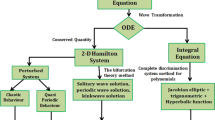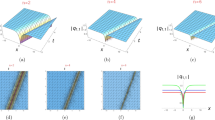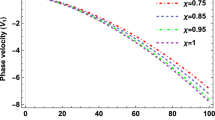Abstract
We first compare two apparently dissimilar expressions for the quality factor Q of inhomogeneous plane waves in isotropic viscoelastic media, where Q is defined as the result of an energy-balance relation. In this case, it is the ratio of twice the strain energy to the dissipated energy. Both expressions give the same Q for P-waves and Q for S-waves is independent of the inhomogeneity angle γ (isotropic media). Then, we consider the more general balance equation, which holds for anisotropic viscoelastic media, where anomalous behaviors are observed when γ exceeds some critical value (forbidden directions of propagation). This problem has already been solved analytically for SH-waves. Here, we consider the qP–qS case, which requires a numerical solution of the dispersion equation to obtain the wavenumber and attenuation factor, i.e., the real and imaginary parts of the wave vector, respectively. The forbidden directions appear when the phase velocity approaches a zero value. Generally, the phase velocity of homogeneous waves (γ = 0) exceeds that of inhomogeneous waves, while the latter show stronger attenuation (lower quality factor). In the vicinity of the forbidden directions, the opposite behavior may occur.




Similar content being viewed by others
REFERENCES
B. D. Zaĭtsev and I. E. Kuznetsova, IEEE Trans. Ultrason., Ferroelectr. Freq. Control 50, 1765 (2003).
B. D. Zaĭtsev, A. A. Teplykh, and I. E. Kuznetsova, Dokl. Phys. 52, 10 (2007).
I. Djeran-Maigre and S. V. Kuznetsov, Acoust. Phys. 60, 200 (2014).
S. Moradi and K. Innanen, J. Geophys. Eng. 15, 1811 (2018).
I. B. Morozov, W. Deng, and D. Cao, Geophys. J. Int. 220, 1762 (2020).
X. Liu, F. Youhuab, and C. Dongmei, Acta Phys. Pol. 137, 276 (2020).
P. W. Buchen, Geophys. J. R. Astron. Soc. 23, 531 (1971).
J. M. Carcione, Wave Fields in Real Media, Vol. 38: Theory and Numerical Simulation of Wave Propagation in Anisotropic, Anelastic, Porous and Electromagnetic Media, 3rd ed. (Elsevier, 2014).
J. M. Carcione and F. Cavallini, Wave Motion 18, 11 (1993).
J. M. Carcione and F. Cavallini, Geophysics 60, 522 (1995).
J. M. Carcione and F. Cavallini, IEEE Trans. Antennas Propag. 45, 133 (1997).
V. Červeny and I. Pšenčík, Geophys. J. Int. 161, 197 (2005).
J. M. Carcione and B. Ursin, Geophysics 81, T107 (2016).
J. M. Carcione, Proc. R. Soc. London. Ser. A 457, 331 (2001).
V. Červeny and I. Pšenčík, Geophysics 76, WA51 (2011).
Author information
Authors and Affiliations
Corresponding author
Appendices
APPENDIX A
1.1 Quality Factor for qP–qS Waves in Anisotropic Viscoelastic Media
We report an expression of the quality factor for anisotropic and viscoelastic media based on the energy balance obtained by Carcione and Cavallini [9]. We assume wave propagation in the (x, z)-symmetry plane of an orthorhombic medium, with the positive z-axis pointing downwards. The medium complex and frequency-dependent stiffness components are pIJ, I, J = 1, …, 6 and the mass density is ρ. We consider the general plane-wave solution (1), where the wave vector is k = (k1, k3) = ω(s1, s3), where si are slowness components. The k3-component in terms of the horizontal wavenumber k1 is
where
The signs in k3 correspond to (+, −): downward propagating qP wave; (+, +): downward propagating qS wave; (−, −): upward propagating qP wave; and (−, +): upward propagating qS wave. The plane-wave eigenvectors (polarizations) are
where V0 is the plane-wave amplitude and
and
In general, the + and − signs correspond to the qP- and qS-waves, respectively. However one must choose the signs such that ξ varies smoothly with the propagation angle.
Then, the quality factor for anisotropic media is given by equation (11), where
In the isotropic case the above components k1 and k3 are equivalent to equation (12). In the anisotropic case, a numerical solution is required to obtain k1 and k3, i.e., the calculation of κ and α, but in this case, equation (A.1) is the analytical solution for homogeneous waves.
APPENDIX B
1.1 Quality Factor of S-waves for Inhomogeneous Waves
For S-waves (isotropic media),
Since µ = µR + iµI and taking real and imaginary parts, we obtain
Substituting equations (B.2) into equation (10), we obtain
which is the S-wave Q factor of homogeneous plane waves, independent of the inhomogeneity angle γ (see Eqs. (3.32) in Carcione [8]). This result is also valid for SH-waves.
Rights and permissions
About this article
Cite this article
José M. Carcione, Liu, X., Greenhalgh, S. et al. Quality Factor of Inhomogeneous Plane Waves. Acoust. Phys. 66, 598–603 (2020). https://doi.org/10.1134/S1063771020060111
Received:
Revised:
Accepted:
Published:
Issue Date:
DOI: https://doi.org/10.1134/S1063771020060111




